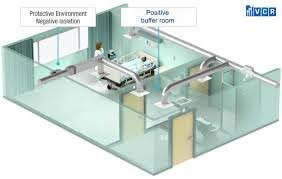Buffer Area and Its Maintenance in Sterile Facility

🔹 Buffer Area in Sterile Facility
1. Definition
-
The Buffer Area (also called the cleanroom or critical area) is a Class 100 / ISO 5 / Grade A-B environment where aseptic processing, sterile filling, and direct product exposure operations are performed.
-
It is surrounded by a supporting cleanroom (ante-room or gowning area) to minimize contamination risks.
-
Critical equipment like Laminar Airflow Hoods (LAF), RABS, or Isolators are placed here.
2. Design Features
-
HEPA-filtered air supply with ≥ 90–100 air changes per hour (depending on classification).
-
Unidirectional airflow (UAF / laminar flow): ~0.3–0.45 m/s at working level.
-
Positive pressure differentials (≥10–15 Pa) maintained between buffer and adjacent areas.
-
Smooth, non-shedding surfaces (walls, ceiling, flooring).
-
Restricted access—only trained personnel with sterile garments.
-
No sinks, drains, or unnecessary equipment inside.
3. Environmental Classification
-
Grade A (ISO 5): Laminar airflow work zone, sterile filling, open product handling.
-
Grade B (ISO 7 background): Buffer zone surrounding Grade A.
-
Grades C & D: Supportive areas (e.g., component preparation).
4. Maintenance of Buffer Area
a) Cleaning & Disinfection
-
Daily cleaning: Sterile filtered disinfectants (rotated—e.g., sporicidal + alcohol).
-
Routine schedule:
-
Before & after each shift → Work surfaces wiped with sterile 70% IPA.
-
Daily → Floors cleaned with sterile disinfectant.
-
Weekly → Walls, windows, equipment surface cleaning.
-
Monthly/Quarterly → Ceiling, behind equipment, hard-to-reach areas.
-
-
Disinfectant rotation: Prevents microbial resistance.
b) Environmental Monitoring (EM)
-
Airborne particulate monitoring: Continuous/periodic with particle counters.
-
Viable monitoring: Settle plates, contact plates, active air samplers, glove prints.
-
Surface monitoring: RODAC plates/swabs.
-
Pressure differential, temperature, RH monitoring: Daily logs.
c) Personnel Practices
-
Proper gowning sequence in ante-room (sterile suits, masks, gloves, overshoes).
-
Minimal movement to reduce turbulence.
-
Strict adherence to aseptic techniques.
-
Periodic training and qualification of operators.
d) Engineering Maintenance
-
HEPA filter integrity testing (smoke test, DOP test): Every 6–12 months.
-
Air velocity & airflow pattern tests: Semi-annually.
-
Pressure differential gauges calibration: Regular intervals.
-
HVAC system preventive maintenance.
e) Documentation
-
Cleaning logs, disinfectant preparation records, EM results, deviation reports.
-
Compliance with cGMP, EU GMP Annex 1, and USP <797>/<800> guidelines.
5. Key Risks if Not Maintained
-
Microbial contamination → Non-sterile product.
-
Cross-contamination between batches.
-
Product recalls, regulatory action, patient safety risks.
✅ Summary
The Buffer Area is the critical aseptic cleanroom zone in sterile manufacturing. Proper design, strict cleaning & disinfection, robust environmental monitoring, controlled personnel entry, and preventive maintenance are essential for sterility assurance and GMP compliance.
🎓 Discover one of the best Complete Pharmaceutical Production Course available —click below to explore the course that’s shaping future Production Course skills.
https://trcjw.on-app.in/app/oc/338669/trcjw

